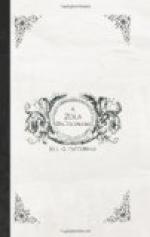EULALIE, a fish-seller, mistress of Bec-Sale, alias Boit-sans-soif. L’Assommoir.
EULALIE (LA MERE), a vegetable seller at Montmartre. She lodged with Madame Mechain. L’Argent.
EUSEBE, a choir-boy in the church of Saint-Saturnin at Plassans. He accompanied Abbe Bourrette to the deathbed of Abbe Compan. La Conquete de Plassans.
F
FAGEROLLES PERE, a manufacturer of zinc objects of art who lived in a gloomy old house in Rue Vieille-du-Temple. His workshop was on the ground floor, above it was a warehouse, and still higher, facing a courtyard, were the rooms in which he lived with his son Henri. He intended to bring up Henri as a designer of ornaments for his own trade, and when the boy showed higher ambitions, taking to painting proper and talking about the School of Art, there were quarrels, blows, a series of falling-outs and reconciliations. Even when the young man had achieved some success, the manufacturer of artistic zincwork, while resigned to letting him have his will, treated him harshly, like a lad who was spoiling his career. Later, in the desire of a decoration for himself, the merchant forgot his former opposition; he held out his son, who had now arrived at notoriety, as an additional claim for his own distinction. L’Oeuvre.
FAGEROLLES (HENRI), son of the preceding. In the gloomy house of his father he grew up like a true child of the Paris pavements. Though his father desired him to become a designer of ornaments for use in his trade, the lad had higher ambitions, and desiring to study painting, became a student at the School of Art. Notwithstanding this orthodox training, he was a disciple of Claude Lantier and his somewhat revolutionary band, whom he delighted by sly attacks upon his professors and praise of themselves. He paid particular court to Claude, under whose artistic influence he had come, and though he continued to paint with tricky skill, he no longer talked in anything but the jargon of the new open-air school. This did not prevent him, however, from elsewhere making fun of the adepts of that school, whom he accused of doing their work with a kitchen ladle. He made a success with a picture of an actress before her glass, which caught the popular taste, and afterwards appeared as an engraving. Taken up by Naudet, the picture-dealer, he began to receive large prices for his work, and by doing everything in his power to make his way in society his position soon became secure. He was elected a member of the Hanging Committee of the Salon, and secured the admission of Claude Lantier’s picture L’Enfant Mort. He made large sums of money, in the spending of which he was assisted by Irma Becot. L’Oeuvre.
FANNY (MADEMOISELLE), a work-girl in the neighbourhood of Octave Mouret’s shop, who was sent there by her employer to match some merinos. Au Bonheur des Dames.




